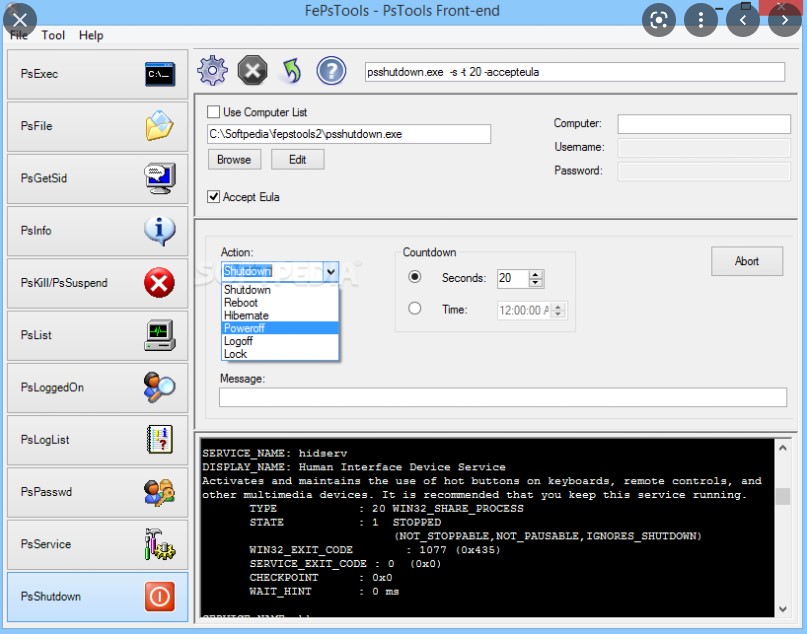These tools can all be used locally, but are most useful for connecting to remote computers or performing commands on them. PsExec searches the remote system’s windowssystem32 directory for the path to the program. This tool can be used as a command line to execute many orders. It allows you to quickly get information about an application, system process, executes orders, stops services, and many other things. Get More Softwares From Getintopc
Pstools
Password 123
On Unix-like operating system, DOS, and OS/2, PATH specify a list of directories in which executable programs are found. Each executing process and each user session have their own PATH settings. info, PsList, and PsLogList require that the remote registry service be enabled on the remote machine. This is not an option in modern Windows versions. You can open Event Viewer, select Connect from the Action menu, and have administrator access to the remote computer.
Pstools Features
This program is widely used in many countries, including the United States, Vietnam, China, and Vietnam. It will instantly open the Run command window if you press both the Windows and R keys simultaneously. This method works with all Windows versions. It is the fastest. Click on the Start button (the Windows icon at the lower-left corner). PsTools offers all the tools you need to manage your business. There are many options, but you will find that there are some that you use more than others.
PsTools is a fantastic tool for network administrators. Hackers can acquire the PsTools suite and make malicious use of them. When running the PsTools suite from the command line interface, there are some requirements. To use the PsTools suite, both the remote and local computers must have file and print sharing enabled.

PsTools is an array of powerful tools that can be used to remotely control a computer using the command line. It will allow you to manage your local system and run processes. You can also execute them and manage users and passwords. PsTools has a lot of great commands that can be used to remotely access a computer. These tools could be used by an IT professional, or a network administrator.
Open an elevated Command Prompt from the directory in which PsTools was extracted. Use your elevated Command Prompt to type psexec, and hit the enter key.
This utility can be used to log off, shut down, or put your computer into sleep mode. It is not as good as the built-in shutdown.exe utility. This utility was designed for Windows XP and is recommended in most cases. If you need to troubleshoot your network, there are many advanced options available to this command. This utility is very simple but can be used to quickly check a computer’s CPU and memory. To narrow down the list to a specific problem application, you can use the command line to specify the name or part thereof. You can also see all information, including threads.
How to Get Pstools for Free
To see these options, you can simply run psexec directly from the prompt. This would place the netstat list of open connections into the home directory of the remote user, in a file called connections.txt. This section can be ignored if you are not in a domain environment. Most people who use PsTools are. Being a great sysadmin requires the ability to think faster and do things better.
You probably understand the importance of having complete control of your computer if you are a power user. This is true even if your job is to manage computers or systems administrators.
You will see the output of the commands on your local computer, not on the remote one. Pool is a command-line package that includes tools such as psexec and pslist. service, logon, and some other PsTools allow you to manage remote AND local systems. This is great because we need to do remote stuff.
You don’t need to install it. Simply download the PsTools zip file and extract it. PsExec can’t be used as a standalone tool and is part of the PsTools suite. This toolset allows you to manage both local and remote systems. This utility lists all accounts that have been logged on to the machine, or remotely. It is very simple and useful for system administrators. This command provides a lot of useful information, including uptime. To test it, you can simply type info at a command prompt. This assumes your SysInternals tools will be in the path.
Init or the given PID is the root of the tree. Administrators can execute system commands remotely using PowerShell and PsExec, with minimal overhead or configuration. The application is packed with powerful tools. You’ll also be able to use it quickly. This interface gives you greater control and is, therefore, more powerful. PsExec searches the remote system’s windowssystem32 directory for the path to the program. This command is very simple. It kills processes by name or ID. You can also use the -t switch if you wish to kill the entire process tree.
It is important to mention the SysInternals -acceptable option. This will ensure that the EULA is accepted on the computer where it was run. This must be added to the autorunsc.exe script or it will fail on remote computers. This problem is not necessary if you’re in a domain environment.
Pstools System Requirements
- Operating System: Windows XP/Vista/7/8/8.1/10
- RAM: 1 GB
- Hard Disk: 100 MB
- Processor: Intel Dual Core or higher processor
